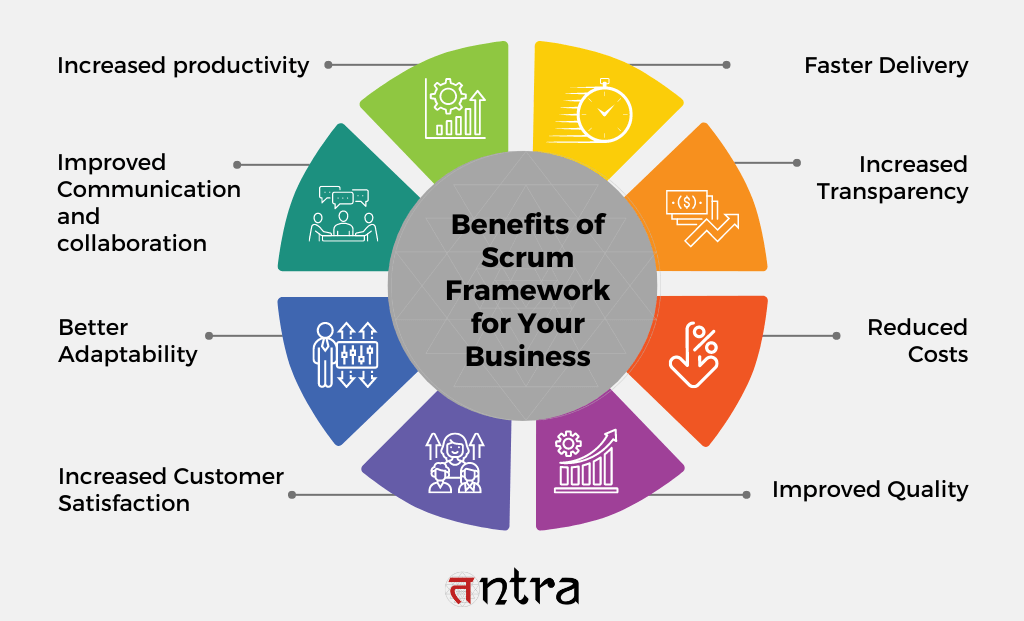
The Impact of Scrum: Enhancing Work Quality, Productivity, and Work-Life Balance
Table of Contents
ToggleScrum, a popular project management framework, offers organizations a way to efficiently manage complex work by breaking it down into smaller, manageable tasks. However, to make the most of Scrum, it is crucial to adapt it to your organization’s specific needs. This blog explores critical considerations for adapting Scrum, including understanding its purpose, assessing current processes, defining roles and goals, creating backlogs, monitoring progress, and fostering continuous improvement. By tailoring Scrum to their unique requirements, organizations can enjoy increased productivity, collaboration, adaptability, customer satisfaction, faster delivery, transparency, cost reduction, and improved quality.
What is Scrum Framework?
Scrum is an Agile framework that supports teams to approach tasks incrementally, embracing experimentation and feedback loops for continuous learning and growth. It provides the proper structure to fit seamlessly into workflows while accommodating specific requirements. Decisions in Scrum are made empirically, drawing on observation, experience, and experimentation. The framework’s pillars of transparency, inspection, and adaptation support iterative development, fostering a mindset of conducting small experiments, learning from the results, and adjusting methods as needed.
A Scrum team is a cohesive and adaptable group committed to achieving product milestones within agreed-upon timeframes. Typically comprised of around 10 individuals, the team’s size is designed to ensure they can efficiently complete substantial work during each sprint. The critical roles within a Scrum team include the development team, responsible for executing the work; the Scrum Master, who facilitates the Scrum process; and the Product Owner, who represents the stakeholders and defines the product vision.
Additionally, as Agile teams are cross-functional, the development team may encompass various roles, such as testers, designers, UX experts, and ops engineers, ensuring comprehensive expertise.
In Scrum, the emphasis is on fostering a collaborative Scrum environment where teams can deliver value gradually and collectively. By leveraging empirical thinking and embracing the principles of transparency, inspection, and adaptation, Scrum empowers teams to adopt an iterative approach to development, continuously improving and responding to changing circumstances.
Impact of Scrum on Work Quality, Productivity, and Work-Life Balance
Scrum, a project management system that has gained widespread adoption, has considerably impacted work quality, productivity, and work-life balance. Scrum has demonstrated benefits for work quality, productivity, and teamwork-life balance through empirical thinking, iterative development, and a focus on transparency and flexibility.
1) With 81% of Agile teams using it in some capacity, Scrum practices, a widely adopted project management style, has gained significant appeal.
2) The fact that 78% of Scrum users indicate a strong readiness to advocate the approach to their peers demonstrates the efficacy of Scrum.
3) According to empirical studies, teams that adopt Scrum entirely and utilize workload estimating see a startling 250% improvement in work quality compared to teams that don’t.
4) Teams using Scrum experience a considerable reduction in defect density, with an average of fewer than 10 errors, compared to teams not using Scrum, who typically experience over 20 mistakes.
5) Scrum also excels in productivity, with teams claiming 3–4 times higher productivity. The most effective Scrum teams have increased productivity by up to 8 times.
6) Scrum also favors teams’ ability to combine work and personal obligations; 85% of teams who use it say their work lives have improved.
Witness the future of pharmacy with our groundbreaking case study!
Adapting Scrum for Organizational Success: Key Considerations for Effective Scrum Implementation
Scrum is a popular framework for managing projects, but as with any framework, it’s essential to understand that it is not a one-size-fits-all solution. To get the most out of Scrum software development teams, it’s vital to know how to adapt it to your organization’s specific needs. This section will explore some critical considerations for adapting Scrum to your organization.
- Understand the purpose of Scrum Methodologies:
- Before you can adapt Scrum to your organization, you need to understand the purpose of Scrum. Scrum is a framework designed to help organizations manage complex, adaptive work by breaking it down into smaller chunks and regularly tracking progress. By understanding the purpose of Scrum, you can better understand how to adapt it to your organization.
- Assess the current processes:
- Before adopting Scrum, it’s crucial to assess the existing procedures and practices that are in place in your organization. This will help you to identify areas where Scrum can be implemented to improve efficiency and effectiveness.
- Define roles and responsibilities:
- One of the key elements of Scrum is the definition of roles and responsibilities. It’s important to define roles such as Scrum Masters, Product Owner, and Development Team members and understand the responsibilities of each role.
- Define and prioritize goals:
- Scrum is goal-driven, so it’s important to define and prioritize the organization’s goals and align them with the goals of the Scrum team.
- Create a backlog:
- A backlog is a list of tasks that must be completed to achieve the organization’s goals. It’s important to create a backlog and prioritize the tasks based on their importance.
- Monitor progress regularly:
- One of the key principles of Scrum is to monitor progress regularly. It’s important to set up regular meetings such as daily stand-ups, sprint planning, sprint review, and retrospectives to track progress and adjust as needed.
- Continuously improve:
- Scrum is an iterative process, and it’s essential to improve the procedures and practices continuously. It’s important to review the processes and make adjustments as needed regularly.
Benefits of Scrum Framework for Your Business
Scrum provides several benefits for organizations. Here are a few key benefits of Scrum:

- Increased productivity:
- Scrum helps organizations to manage complex, adaptive work by breaking it down into smaller chunks and tracking progress regularly. This helps to increase productivity and efficiency.
- Improved communication and collaboration:
- Scrum encourages regular team member interaction and collaboration, which enhances the team’s performance as a whole.
- Better adaptability:
- Scrum is an iterative process, meaning teams can continuously improve and adapt their processes and practices as needed. This helps organizations to be more adaptable and respond quickly to changing conditions.
- Increased customer satisfaction:
- The use of Scrum puts the customer at the center of the process and encourages regular feedback, which helps organizations to deliver products and services that meet the needs and expectations of the customer.
- Faster delivery:
- Scrum helps organizations to deliver products and services faster by breaking down work into smaller chunks and tracking progress regularly.
- Increased transparency:
- Scrum provides a clear and transparent view of the progress of a project, which helps organizations to identify and resolve issues quickly.
- Reduced costs:
- Scrum helps organizations to reduce costs by increasing productivity, reducing waste, and delivering products and services faster.
- Improved quality:
- Scrum IT professionals are encouraged by regularly testing and feedback, which helps organizations to deliver high-quality products and services.
Revolutionize care delivery with our Electronic Visit Verification system!
Conclusion
Adapting Scrum to your organization requires a deep understanding of the framework, the current processes and practices, and goals. By following these key considerations, organizations can effectively adapt Scrum to their specific needs and improve their project management processes. Remember that Scrum is a flexible framework that should be tailored to fit your organization, not the other way around.
Scrum provides several benefits for organizations, including increased productivity, improved communication and collaboration, better adaptability, increased customer satisfaction, faster delivery, increased transparency, reduced costs, and improved quality. By implementing Scrum, organizations can improve their project management processes and achieve their goals more effectively.
Ready to level up your software development with Scrum? Contact Tntra today.





